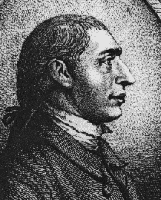A Biography of Gouverneur Morris 1752-1816
 Of French and English descent, Morris was born at Morrisania estate, in Westchester (present
Bronx) County, NY, in 1752. His family was wealthy and enjoyed a long record of public service.
His elder half-brother, Lewis, signed the Declaration of Independence.
Of French and English descent, Morris was born at Morrisania estate, in Westchester (present
Bronx) County, NY, in 1752. His family was wealthy and enjoyed a long record of public service.
His elder half-brother, Lewis, signed the Declaration of Independence.
Gouverneur was educated by private tutors and at a Huguenot school in New Rochelle. In early life, he lost a leg in a carriage accident. He attended King's College (later Columbia College and University) in New York City, graduating in 1768 at the age of 16. Three years later, after reading law in the city, he gained admission to the bar.
When the Revolution loomed on the horizon, Morris became interested in political affairs. Because of his conservatism, however, he at first feared the movement, which he believed would bring mob rule. Furthermore, some of his family and many of his friends were Loyalists. But, beginning in 1775, for some reason he sided with the Whigs. That same year, representing Westchester County, he took a seat in New York's Revolutionary provincial congress (1775-77). In 1776, when he also served in the militia, along with John Jay and Robert R. Livingston he drafted the first constitution of the state. Subsequently he joined its council of safety (1777).
In 1777-78 Morris sat in the legislature and in 1778-79 in the Continental Congress, where he numbered among the youngest and most brilliant members. During this period, he signed the Articles of Confederation and drafted instructions for Benjamin Franklin, in Paris, as well as those that provided a partial basis for the treaty ending the War for Independence. Morris was also a close friend of Washington and one of his strongest congressional supporters.
Defeated in his bid for reelection to Congress in 1779 because of the opposition of Gov. George Clinton's faction, Morris relocated to Philadelphia and resumed the practice of law. This temporarily removed him from the political scene, but in 1781 he resumed his public career when he became the principal assistant to Robert Morris, Superintendent of Finance for the United States, to whom he was unrelated. Gouverneur held this position for 4 years.
Morris emerged as one of the leading figures at the Constitutional Convention. His speeches, more frequent than those by anyone else, numbered 173. Although sometimes presented in a light vein, they were usually substantive. A strong advocate of nationalism and aristocratic rule, he served on many committees, including those on postponed matters and style, and stood in the thick of the decisionmaking process. Above all, it was apparently he who actually drafted the Constitution.
Morris subsequently left public life for a time to devote his attention to business. Having purchased the family home from his half-brother, Lewis, he moved back to New York. Afterward, in 1789, Gouverneur joined in a business venture with Robert Morris, and traveled to France, where he witnessed the beginnings of the French Revolution.
Morris was to remain in Europe for about a decade. In 1790-91 he undertook a diplomatic mission to London to try to negotiate some of the outstanding problems between the United States and Great Britain. The mission failed, but in 1792 Washington appointed him as Minister to France, to replace Thomas Jefferson. Morris was recalled 2 years later but did not come home. Instead, he traveled extensively in Europe for more than 4 years, during which time he handled his complicated business affairs and contemplated the complex political situation.
Morris returned to the United States in 1799. The next year, he was elected to finish an unexpired term in the U.S. Senate. An ardent Federalist, he was defeated in his bid for reelection in 1802 and left office the following year.
Morris retired to a glittering life at Morrisania, where he had built a new residence. In 1809 he married Anne Cary (Carey) Randolph of Virginia, and they had one son. During his last years, he continued to speak out against the Democratic-Republicans and violently opposed the War of 1812. In the years 1810-13 he served as chairman of the Erie Canal Commission.
Morris died at Morrisania in 1816 at the age of 64 and was buried at St. Ann's Episcopal Churchyard, in the Bronx, New York City.
